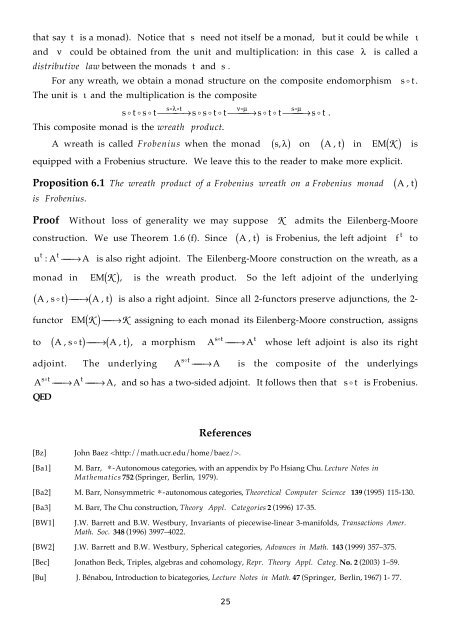Frobenius monads and pseudomonoids Introduction - ResearchGate
Frobenius monads and pseudomonoids Introduction - ResearchGate
Frobenius monads and pseudomonoids Introduction - ResearchGate
Create successful ePaper yourself
Turn your PDF publications into a flip-book with our unique Google optimized e-Paper software.
that say t is a monad). Notice that s need not itself be a monad, but it could be while i<br />
<strong>and</strong> n could be obtained from the unit <strong>and</strong> multiplication: in this case l is called a<br />
distributive law between the <strong>monads</strong> t <strong>and</strong> s .<br />
For any wreath, we obtain a monad structure on the composite endomorphism so t.<br />
The unit is i <strong>and</strong> the multiplication is the composite<br />
solot nom som<br />
sotosot æææÆsosotot æ æÆsotot æ æ Æsot<br />
.<br />
This composite monad is the wreath product.<br />
A wreath is called <strong>Frobenius</strong> when the monad ( s, l)<br />
on ( A , t)<br />
in EM( K ) is<br />
equipped with a <strong>Frobenius</strong> structure. We leave this to the reader to make more explicit.<br />
Proposition 6.1 The wreath product of a <strong>Frobenius</strong> wreath on a <strong>Frobenius</strong> monad ( A , t)<br />
is <strong>Frobenius</strong>.<br />
Proof Without loss of generality we may suppose K admits the Eilenberg-Moore<br />
construction. We use Theorem 1.6 (f). Since ( A , t)<br />
is <strong>Frobenius</strong>, the left adjoint f t<br />
t t<br />
u : A æÆ æ A is also right adjoint. The Eilenberg-Moore construction on the wreath, as a<br />
monad in EM( K ), is the wreath product. So the left adjoint of the underlying<br />
A , s t A , t<br />
o<br />
( ) æÆ æ ( ) is also a right adjoint. Since all 2-functors preserve adjunctions, the 2-<br />
functor<br />
EM( K ) æÆ æ K assigning to each monad its Eilenberg-Moore construction, assigns<br />
( ) æÆ<br />
to A , sot æ ( A , t),<br />
a morphism<br />
st o t<br />
A æÆ æ A whose left adjoint is also its right<br />
st o<br />
adjoint. The underlying A æÆ æ A is the composite of the underlyings<br />
st o t<br />
A æÆ æ A æ ÆA,<br />
<strong>and</strong> so has a two-sided adjoint. It follows then that<br />
QED<br />
References<br />
[Bz] John Baez .<br />
[Ba1] M. Barr, *-Autonomous categories, with an appendix by Po Hsiang Chu. Lecture Notes in<br />
Mathematics752 (Springer, Berlin, 1979).<br />
to<br />
sot is <strong>Frobenius</strong>.<br />
[Ba2] M. Barr, Nonsymmetric *-autonomous categories, Theoretical Computer Science 139 (1995) 115-130.<br />
[Ba3] M. Barr, The Chu construction, Theory Appl. Categories 2 (1996) 17-35.<br />
[BW1] J.W. Barrett <strong>and</strong> B.W. Westbury, Invariants of piecewise-linear 3-manifolds, Transactions Amer.<br />
Math. Soc. 348 (1996) 3997–4022.<br />
[BW2] J.W. Barrett <strong>and</strong> B.W. Westbury, Spherical categories, Advances in Math. 143 (1999) 357–375.<br />
[Bec] Jonathon Beck, Triples, algebras <strong>and</strong> cohomology, Repr. Theory Appl. Categ. No. 2 (2003) 1–59.<br />
[Bu] J. Bénabou, <strong>Introduction</strong> to bicategories, Lecture Notes in Math. 47 (Springer, Berlin, 1967) 1- 77.<br />
25
















